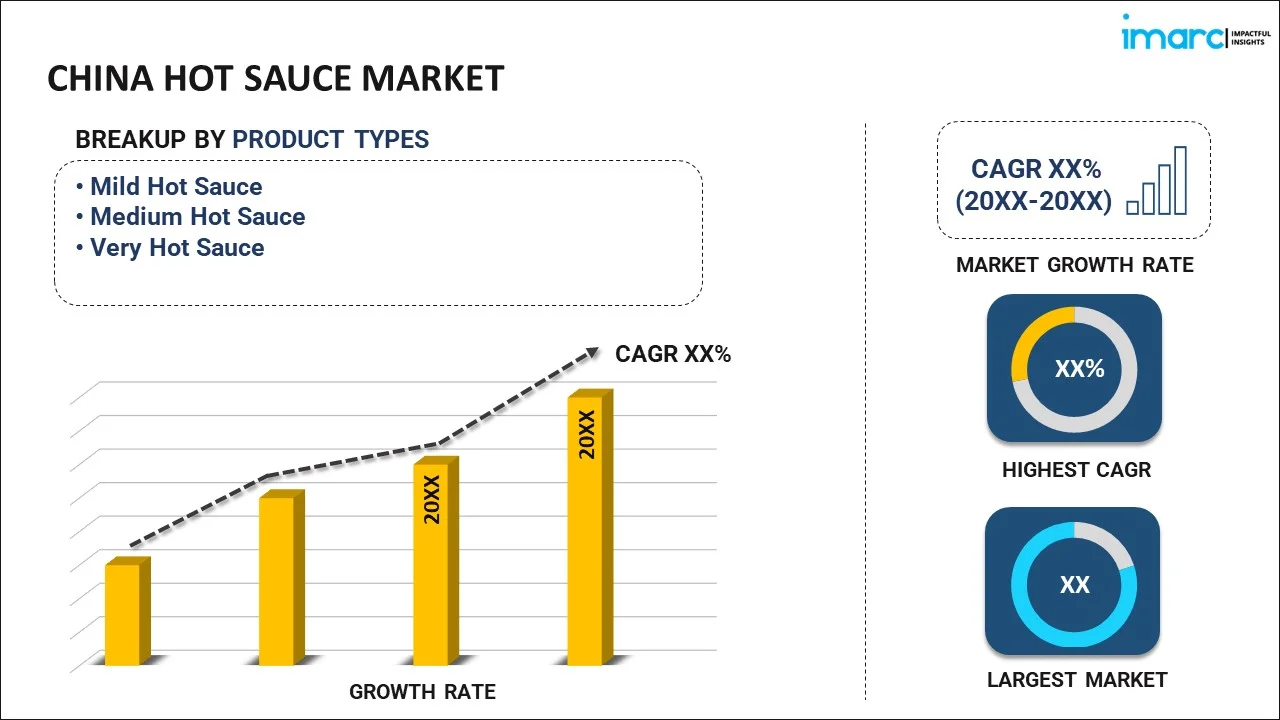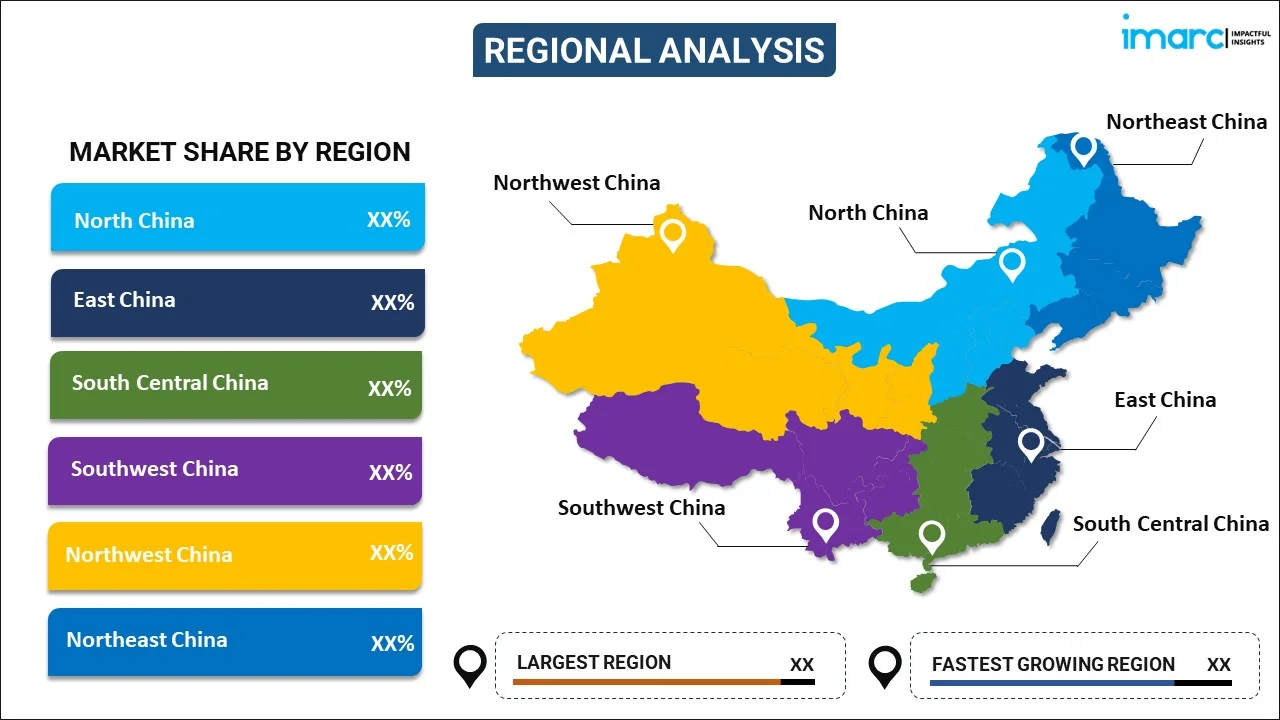
China Hot Sauce Market Report by Product Type (Mild Hot Sauce, Medium Hot Sauce, Very Hot Sauce), Application (Cooking Sauce, Table Sauce), End Use (Commercial, Household), Packaging (Jars, Bottles, and Others), Distribution Channel (Supermarkets and Hypermarkets, Traditional Grocery Retailers, Online Stores, Direct Sales, and Others), and Region 2024-2032
China Hot Sauce Market Overview:
The China hot sauce market size is projected to exhibit a growth rate (CAGR) of 6.20% during 2024-2032. Increasing popularity of international cuisines, rising disposable incomes, rapid urbanization and fast-paced lifestyles, social media influence, dining out trends, health benefits of chili peppers, expansion of e-commerce, food delivery services, and innovative product offerings are some of the factors boosting the market growth.
|
Report Attribute
|
Key Statistics
|
|---|---|
|
Base Year
|
2023 |
|
Forecast Years
|
2024-2032
|
|
Historical Years
|
2018-2023
|
| Market Growth Rate (2024-2032) | 6.20% |
China Hot Sauce Market Trends:
Rising Popularity of International Cuisines
The Chinese market is witnessing an increasing fascination with international cuisines, significantly influencing the hot sauce market. Young consumers, in particular, are eager to explore global culinary traditions, leading to a surge in demand for condiments like hot sauces that are integral to many international dishes. This trend is driven by greater exposure to different cultures through travel, media, and the proliferation of foreign restaurants in major cities. As a result, hot sauces, which are staples in cuisines such as Mexican, Korean, and Thai, are becoming more common in Chinese households. This growing appreciation for diverse flavors is prompting local manufacturers to innovate and introduce a wider variety of hot sauces that cater to these evolving tastes, thereby expanding the market.
Expanding Middle Class Population with Higher Disposable Incomes
The rise of China's middle class is a major factor in the growth of the hot sauce market. China has seen one of the largest concentrations of new middle-class people in the world, running from 39.1 million in 2000 (3.1% of population) to nearly 707 million by 2018 (50.8%). With disposable income on the rise, the middle-class demographic is more likely to try new premium food items. The surging expenditure on quality goods as well as novelty foods has allowed them to develop a taste for indulgent food such as hot sauces within their diet. It further solidified with a global trend in food and a renewed interest in cooking at home beyond basic skills. As a result, the market is witnessing an increase in imported and locally manufactured hot sauces, which are meant to cater the discerning tastes and preferences of upper-middle class.
Increasing Urbanization and Fast-Paced Lifestyle
China has experienced extensive urbanization and a cultural shift in dietary habits due to which the hot sauce market is probable to expand rapidly. While some people may prefer life at a more convenient pace, others shift to urban areas and adopt the faster-paced lifestyle. This lifestyle in urban areas usually increases the requirement for ready to eat and easy to make food products, and thus hot sauce are one of them. Hot sauces are a go-to to add flavor to some plain food -and in an urban city, the convenient fast meal really does not exist- Urban residents often have more money than time, meaning they are working extremely long hours and having less time to cook, a trend that is driving the growth for hot sauces like Grillo. You can see it with the number of hot sauces that make their way into city grocery stores and online grocers in urban markets to serve the needs of a population on-the-go.
China Hot Sauce Market News:
- In 2023, Lee Kum Kee announced to expand its reach in Southeast Asia (SEA), India, and Middle East. it is keeping up with the times through flavor localization and staying attuned to global trends by introducing heathier options and convenience sauces.
China Hot Sauce Market Segmentation:
IMARC Group provides an analysis of the key trends in each segment of the market, along with forecasts at the country level for 2024-2032. Our report has categorized the market based on product type, application, end use, packaging, and distribution channel.
Product Type Insights:

- Mild Hot Sauce
- Medium Hot Sauce
- Very Hot Sauce
The report has provided a detailed breakup and analysis of the market based on the product type. This includes mild hot sauce, medium hot sauce, and very hot sauce.
Application Insights:
- Cooking Sauce
- Table Sauce
A detailed breakup and analysis of the market based on the application have also been provided in the report. This includes cooking sauce and table sauce.
End Use Insights:
- Commercial
- Household
The report has provided a detailed breakup and analysis of the market based on the end use. This includes commercial and household.
Packaging Insights:
- Jars
- Bottles
- Others
A detailed breakup and analysis of the market based on the packaging have also been provided in the report. This includes jars, bottles, and others.
Distribution Channel Insights:
- Supermarkets and Hypermarkets
- Traditional Grocery Retailers
- Online Stores
- Direct Sales
- Others
The report has provided a detailed breakup and analysis of the market based on the distribution channel. This includes supermarkets and hypermarkets, traditional grocery retailers, online stores, direct sales, and others.
Regional Insights:

- North China
- East China
- South Central China
- Southwest China
- Northwest China
- Northeast China
The report has also provided a comprehensive analysis of all the major regional markets, which include North China, East China, South Central China, Southwest China, Northwest China, and Northeast China.
Competitive Landscape:
The market research report has also provided a comprehensive analysis of the competitive landscape. Competitive analysis such as market structure, key player positioning, top winning strategies, competitive dashboard, and company evaluation quadrant has been covered in the report. Also, detailed profiles of all major companies have been provided.
China Hot Sauce Market Report Coverage:
| Report Features | Details |
|---|---|
| Base Year of the Analysis | 2023 |
| Historical Period | 2018-2023 |
| Forecast Period | 2024-2032 |
| Units | US$ Million |
| Scope of the Report | Exploration of Historical and Forecast Trends, Industry Catalysts and Challenges, Segment-Wise Historical and Predictive Market Assessment:
|
| Product Types Covered | Mild Hot Sauce, Medium Hot Sauce, Very Hot Sauce |
| Applications Covered | Cooking Sauce, Table Sauce |
| End Uses Covered | Commercial, Household |
| Packagings Covered | Jars, Bottles, Others |
| Distribution Channels Covered | Supermarkets and Hypermarkets, Traditional Grocery Retailers, Online Stores, Direct Sales, Others |
| Regions Covered | North China, East China, South Central China, Southwest China, Northwest China, Northeast China |
| Customization Scope | 10% Free Customization |
| Post-Sale Analyst Support | 10-12 Weeks |
| Delivery Format | PDF and Excel through Email (We can also provide the editable version of the report in PPT/Word format on special request) |
Key Questions Answered in This Report:
- How has the China hot sauce market performed so far and how will it perform in the coming years?
- What has been the impact of COVID-19 on the China hot sauce market?
- What is the breakup of the China hot sauce market on the basis of product type?
- What is the breakup of the China hot sauce market on the basis of application?
- What is the breakup of the China hot sauce market on the basis of end use?
- What is the breakup of the China hot sauce market on the basis of packaging?
- What is the breakup of the China hot sauce market on the basis of distribution channel?
- What are the various stages in the value chain of the China hot sauce market?
- What are the key driving factors and challenges in the China hot sauce?
- What is the structure of the China hot sauce market and who are the key players?
- What is the degree of competition in the China hot sauce market?
Key Benefits for Stakeholders:
- IMARC’s industry report offers a comprehensive quantitative analysis of various market segments, historical and current market trends, market forecasts, and dynamics of the China hot sauce market from 2018-2032.
- The research report provides the latest information on the market drivers, challenges, and opportunities in the China hot sauce market.
- Porter's five forces analysis assist stakeholders in assessing the impact of new entrants, competitive rivalry, supplier power, buyer power, and the threat of substitution. It helps stakeholders to analyze the level of competition within the China hot sauce industry and its attractiveness.
- Competitive landscape allows stakeholders to understand their competitive environment and provides an insight into the current positions of key players in the market.
Need more help?
- Speak to our experienced analysts for insights on the current market scenarios.
- Include additional segments and countries to customize the report as per your requirement.
- Gain an unparalleled competitive advantage in your domain by understanding how to utilize the report and positively impacting your operations and revenue.
- For further assistance, please connect with our analysts.
 Inquire Before Buying
Inquire Before Buying
 Speak to an Analyst
Speak to an Analyst
 Request Brochure
Request Brochure
 Request Customization
Request Customization




.webp)




.webp)












